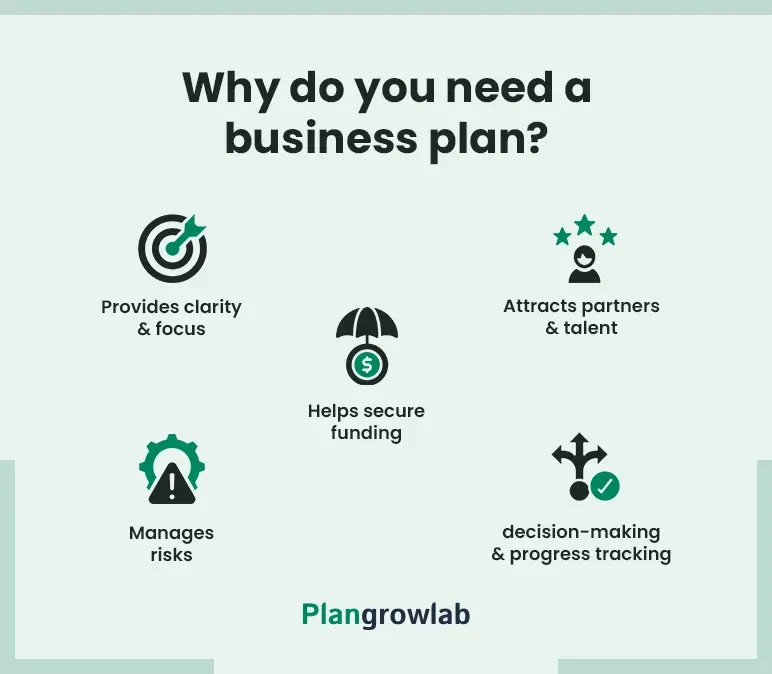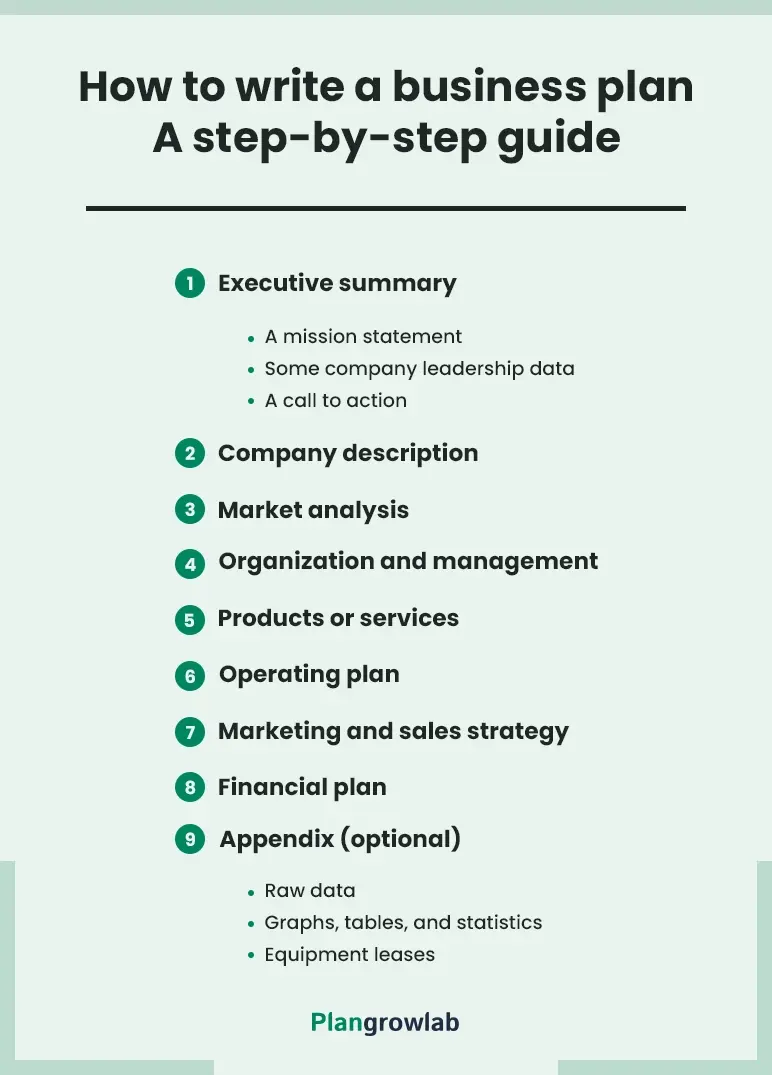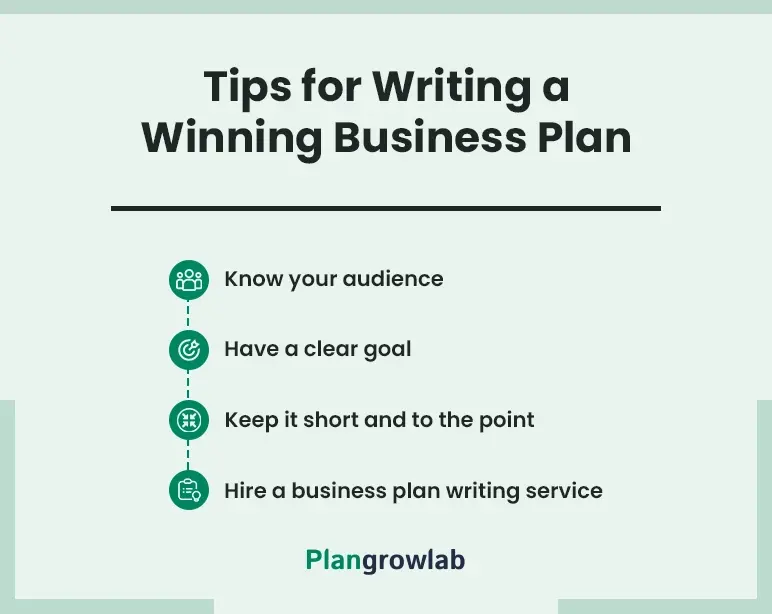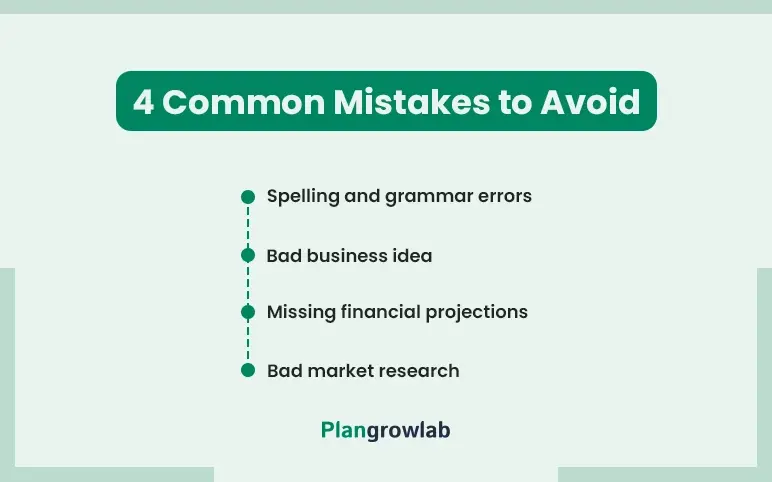On paper, writing a business plan feels simple. Then you try and realize it’s not just about writing. It’s about making decisions.
After working with so many founders, we started to see the same pattern: They have the ideas. What slows them down is the act of putting those ideas into a structure someone else can understand.
The moment the blank doc opens, the questions start:
“Is this the right way to frame it?”
“Should I show this level of detail?”
“Will this sound serious enough?”
These questions come up all the time (usually from early-stage founders) who’ve never had to organize their thinking this way before. The fear of doing it wrong is real. So is the pressure to make it perfect.
But the truth is, most investors (and even your own team) aren’t looking for a flawless document. They’re looking for clarity.
In this article, I’ll walk you through the process we use at PlanGrowLab to help founders write clear, simple, grounded business plans. Let’s get started.
What is a business plan?
A business plan is a formal document that outlines a business's objectives, strategies, and operational procedures. It typically includes the following information about a company:
- Products or services
- Target market
- Competitors
- Marketing and sales strategies
- Financial plan
- Management team
A business plan serves as a roadmap for a company's success and provides a blueprint for its growth and development. It helps entrepreneurs and business owners organize their ideas, evaluate their feasibility, and identify potential challenges and opportunities.
As well as serving as a guide for business owners, a business plan can attract investors and secure funding. It demonstrates the company's understanding of the market, its ability to generate revenue and profits, and its strategy for managing risks and achieving success.
Why do you need a business plan?
Plenty of studies will tell you that founders with a business plan are more likely to succeed. HBR found a 16% increase in long-term performance. Another survey revealed that 28% of businesses with business plans secured investment capital, compared to 12% without any.
I could quote more stats, but you already know the point: writing a business plan isn’t a formality.
We’ve seen it firsthand.
When founders come to us unsure about their next steps like launching, pivoting, or raising capital, the first thing we do is look at the plan.
Or more often, help them build one from scratch. Not because investors expect it (they do), but because the process forces the clarity most founders are missing.

Here are more reasons why having one is crucial:
1. Provides clarity and focus
A business plan forces you to define your goals, target market, and strategies clearly. It’s like turning a vague idea into a concrete roadmap, so the journey ahead is smooth.
2. Helps secure funding
A business plan helps you make your idea viable, backed by valuable data such as financial projections, sales tactics, market opportunities, and your ability to generate ROI. This is important proof for potential investors and lenders.
3. Attracts partners and talent
A well-crafted business plan showcases your vision and direction. This makes it easier to attract strategic partners and top talent who want to join a well-thought-out and focused enterprise.
4. Manages risks
With a business plan, identifying potential challenges early is easy like anticipating cash flow problems and handling market shifts. As a result, you can better prepare to mitigate risks.
5. Improves decision-making and progress tracking
As a dynamic document, a business plan helps track milestones, monitor growth, and adapt strategies. As a result, it helps with better decision-making with evolving changes.
With that said, let’s learn…
How to write a business plan: A step-by-step guide
Here’s a simple guide that will halve your fears associated with business plan creation:

Executive summary
Just like how the pilot episode of a series sets the tone for the entire show, the executive summary (first section) will set the tone for the entire business plan.
It should include:
- A mission statement
- A brief description of your business's products or services
- Some company leadership data
- A broad summary of your financial growth plans
- Funding request (if you want to raise capital)
- A call to action
This will allow you to express to a reader why you will be successful. Most founders we work with don’t get this section right on the first try and that’s normal. We usually help reframe it after the full plan is done. That way, it actually captures the key points without sounding forced or generic.
Company description
With the pilot done, you now want to start the protagonist’s (company) story by describing them and their traits. So create a company description by including the following briefly:
- Business history such as founding information, milestones achieved, growth so far, and more.
- A list of products and services you’ll offer and how they’ll solve the problem.
- Business’s physical location (if any) to reveal the address, plans of expansion, and location’s significance.
- The problem your product or service addresses
- Names of key people in the business like founders, leaders, and board members.
- Business objectives, both short and long-term
Market analysis
Did you know that 42% of businesses fail due to no demand in the market?
This scary percentage is why you want to care about market analysis. It requires you to validate enough demand for your product or service to enter and grow.
But that’s not it. In this section, you need to do a thorough market analysis revealing the following (explained using a car repair company’s example):
| Data Type | Details |
|---|---|
| Industry overview | Key trends and insights |
| Target market | Who are your customers? What are their pain points? |
| Competitive analysis | Identify competitors, their strengths, and weaknesses. As well as how you plan to compete against them to gain a competitive advantage. |
| Regulatory environment | Identify and discuss any laws, regulations, or industry standards you need to adhere to and they may affect your business model or cost. |
| Barriers to entry | Highlight obstacles like capital requirements, technological expertise, or regulatory hurdles. Explain how you plan to overcome these barriers. |
We often spend the most time here during consulting sessions because framing it in a way that proves demand and shows real market fit is a different skill. That’s where founders get stuck.
Organization and management
Irrespective of whether the business plan is for internal teams or external ones, explain your company’s family tree. This will tell the reader how your company will be structured and who will run it.
Start by mentioning the legal structure of your business. This can be a:
- C or an S corporation
- General or limited partnership
- Sole proprietorship or limited liability company (LLC)
Here’s a quick explanation and comparison of all the structures you can quickly make a choice as well:
| Different Business Structures: Comparison | |||||
|---|---|---|---|---|---|
| Business structure | Sole Proprietorship | LLC | Partnership | C-Corporation | S-Corporation |
| Ownership | One individual runs the company | One or more individuals run the company | Two or more people run the company | One or more people run the company | One or more (<100 ) individuals run the company |
| Taxes | Personal & self-employment tax | Corporate, personal, or self-employed tax | Personal & self-employment tax. Partners with limited liability aren’t included | Corporate tax | Personal tax |
| Liability | Unlimited personal liability | The owner(s) isn’t personally liable for company liabilities | Unlimited partner liabilities. (Limited if registered as a limited liability partnership) | All owners are free of personal liability | Owners aren’t personally liable for the company’s liabilities |
Next, use an organizational chart to lay out who's in charge of what, the hierarchy, and the flow of operations in your company.
Elaborate on each person's unique skills and expertise, especially higher-ups and department leads so your audience can judge how successful your future looks.
In fact, this is also a good time to mention your hiring plan to:
- Show the immediate hires you’ll make based on positions you don’t have anyone in place but matters for investors.
- Outline plans for future recruitment (including timelines and roles to be filled as the business grows).
One thing we often fix: Founders list the structure but forget to link it to decision-making or investor needs. We help clean this up and tie it to the funding story so it supports your ask.
Products or services
In the product and services section of your plan, you must showcase your products and services in much detail.
- What’s your product or service? (Highlight aspects like quality, price, innovation, or customer experience.)
- How does it work?
- What are your plans for expanding your product line or adding services?
- What’s the pricing model for your product or service?
- What’s your supply chain and order fulfillment strategy?
- Unique Value Proposition (What sets your product/service apart from competitors?)
- How do your product and service features translate into benefits for your customers?
Answering the questions should help investors, partners, or stakeholders grasp the value of your offerings.
Additional details you can include:
- Provide proof of effectiveness (if available) such as customer testimonials or case studies.
- Mention ongoing improvements or new product development efforts (R&D).
- Share intellectual property (IP) such as patents, trademarks, or proprietary technology, mention it here.
Operating plan
What does your day-to-day look like for your company? Your operating plan gives insight into exactly that in your business plan.
The questions you’ll address in your operating plan may include:
- Will you have a physical location? If so, explain why it works for your company.
- What are the assets you will use and in what parts of your business operations? (Add details depending on operations’ complexity)
- Do you have a customer invoice prepared?
- What expenses are related to running the business?
- Who are your suppliers and why do you prefer them?
- What are the risks in the company’s operations and how do you plan to deal with them?
Some questions will be associated with human resources such as:
- What responsibilities will the management team shoulder?
- What’s the number of staff members and contract workers in your organization?
- How do you recruit and retain staff and contract workers?
- What’s the pay cycle like?
For example, if you run a makeup company, your operations plan would include manufacturing makeup, quality checks (cruelty-free or dermatologically-tested), warehouse operations, order fulfillment, legal, compliance, and more.
This section often ends up vague or too technical. During client reviews, we help translate day-to-day work into language that investors understand.
Marketing and sales strategy
Now this section will have quite the detail for how else will your business make money if not through a marketing plan and sales strategy!
So begin by explaining the strategies you’ll use to attract customers and how you’ll execute them to establish a competitive advantage.
The idea is to showcase:
- Your ability to sell or make money
- Your availability to reach potential customers
- How your brand will stand out
- How your pricing strategy compares to otters in the market
- How you plan to build long-term customer loyalty for repeat business
- Your advertising strategies
We often see founders throw everything into this section—SEO, ads, PR—but miss the actual funnel logic. During planning sessions, we break it down with them into what’s realistic, what’s scalable, and what actually connects with the right customer.
| Section | Key Questions | Details to Include |
|---|---|---|
| Sales Strategy | How will you close deals? | Outline your sales process by including sales channels (directs sales, online, retail), tactics (upselling, promotions, bundling), and team structure (describe roles and responsibilities). |
| Marketing Strategy | How will you reach your audience? | Discuss your marketing channels such as digital marketing (SEO, social media, email campaigns, paid ads), traditional marketing (print ads, events, partnerships.), branding (define your brand identity and messaging), and content strategy (blogs, videos, or other materials to engage your audience). |
| Customer Acquisition and Retention | How will you attract and keep target customers? | Strategies for lead generation, customer onboarding, loyalty programs, and customer service. |
| Competitor Analysis | Who are your competitors? How will you differentiate? |
List direct and indirect competitors, highlighting their strengths and weaknesses. Explain your unique positioning and competitive edge. |
| Marketing Goals and Metrics | What does success look like? | Define KPIs such as customer acquisition cost (CAC), conversion rates, and Customer lifetime value (CLV) |
| Budget | How much will you spend? | Provide a detailed budget for sales and marketing efforts. Break down expenses for advertising, tools, salaries, and campaigns. |
Financial plan
This might be an intimidating section for many, but it’s a critical part of your business plan if you need funding. It reveals your past (if any), current, and near future financial health and information essential to persuade investors and lenders.
They want to know if you can earn profits or have a consistent flow of income which will help you repay their money.
A typical financial plan will include:
- Profit and loss statement (including expected profitability timeline and key drivers affecting profitability.)
- Balance sheet
- Cash flow statement
- Sales forecast
- Break-even analysis
- Projected expenses (rent, salaries, materials, marketing)
- Funding requirements (detailed use of funds
You can start off with a high-level overview and later get into each of the above details. Make sure you use visuals like graphs and charts.
But how do you draw project financials, make appropriate visuals, and generate statements?
The manual process is just too complicated. The best way is to gather all the raw data like the financial statements and feed them into a financial forecasting software.
But guess what?
If you want to take your financial forecasting to the next level, consider bringing in a business planning consultant. They can quickly dive into all the nitty-gritty details of your business and craft a comprehensive business plan—financials and all—so you can focus on what you do best!
Appendix (optional)
The last section in a well-written business plan can be an appendix where you can attach any supporting information or additional materials that you couldn’t fit in elsewhere or make the business plan chunky. That might include:
- Raw data
- Sample calculations and technical figures
- Graphs, tables, and statistics
- Licenses, permits, and patents
- Equipment leases
- Contracts
- Bank statements
- Personal and business credit history (if you need financing)
- Research instruments
- Surveys and interviews: Questionnaire/survey instruments, interview transcripts, and questionnaire results
- Correspondence: Letters, emails, and other copies of correspondence
- Complete field notes from observations
If the appendix is long, you may want to consider adding a table of contents at the beginning of this section.
Review and update business plan
That’s about it for the sections in a business plan. All left to do is review your business plan once it is complete. Once your first draft is ready, conduct multiple rounds of review to ensure your plan precisely delivers the intended message.
- In the first review, look for spelling or grammatical errors, cluttered information, and other writing issues.
- In the second review, look for information gaps, unclear messages, inaccurate financial numbers, and more.
- The third round of review involves sharing it with your partners, team members, and stakeholders.
Remember, a business plan needs regular reviewing and updating, even once it's finalized. Conduct monthly, quarterly, or yearly meetings to review and update your business plan regularly.
Tips for writing a winning business plan
Here are some tips to help you write a business plan to achieve your intent:

1. Know your audience
When you know who’s going to read your plan (internal teams, investors, external stakeholders, etc.) you can tailor the language and detail accordingly. In fact, you can even decide the type of business plan you need such as a traditional, startup, lean, growth, strategic, or one-page business plan.
This will gain you brownie points, especially when requesting funding because who doesn’t love personalization? 🤷
Moreover, knowing your reader helps you determine what details to include and what to hit the cutting room floor.
2. Have a clear goal
A bit obvious but I can’t stress its importance enough.
When crafting a business plan, make sure your goal is crystal clear so that every detail you put in is relevant and valuable instead of fluff and a waste of time.
In client sessions, we often spend time just clarifying this goal. Once it’s clear, the rest flows faster. We guide clients through a quick planning sprint to lock that down early.
3. Keep it short and to the point
Depending on your business purpose and plan type the length may vary but it’s best to keep it short and readable—generally no longer than 15-20 pages.
If you do have additional documents, consider adding them in the appendix section.
4. Hire a business plan writing service
Hiring a business plan consultant will ensure you get years of experience, a human touch, and the high-level research abilities required to write a winning business plan.
This is an ideal option for busy entrepreneurs short on time and needing help writing a plan. This way, they can focus on the more important business aspects.
They even help you update your business plan as and when there are changes.
Common mistakes to avoid
To err is human. But some errors can be avoided while creating a business plan, such as:

1. Spelling and grammar errors
Don't let something as small as a typo jeopardize your chances of securing funding or landing a new partner.
So, it’s best to have a team of editors or proofreaders to spot typos while reading your business plan. If you can’t afford a designated team, share the plan with a friend, family member, or colleague.
We run every client plan through editorial review so that the entire business plan document feels professional, consistent, and credible.
2. Bad business idea
Even the most seasoned entrepreneurs can stumble upon a flawed business idea. It can be because there’s no market or it’s too risky for potential investors.
In such situations, it’s best to hit the drawing board again. Maybe you’re missing a very tiny piece of a big puzzle. Minor fixes and your business idea might just become viable.
3. Missing financial projections
Remember to include your balance sheet, cash flow statements, profit and loss (P&L) statements, and income statements.
Neglecting such important data you risk the chances of losing investors and lenders because they’re not sure if you can make the best of their investment.
4. Bad market research
Whether you do bad, half, or no market research, it’s all the same—a plan to crash. Lack of thorough research can result in inaccurate target market understanding, wrong marketing plan, unclear valuable proposition, wrongly defined sales plan, irrelevant growth strategies, and unrealistic financial projections.
It’s easy to list what’s missing. What actually helps is showing you how to fix it. We work with current data, ask the relevant questions, and make sure your market analysis isn’t just there to prove you’ve done your homework.
Conclusion
Creating a business plan isn’t easy. It has many sections to cover and much research you need to do to fill in each of these. Everything requires thorough research, from the executive summary and mission statement to creating a detailed financial and marketing plan.
But it’s doable if you have the right information regarding your business. In fact, the process can be made easy with a business plan consulting agency.
A consultant will gather all your business data from you and create an entire business plan exactly according to your needs and audience.
So why wait, hire experts today.
Frequently Asked Questions
How long should a business plan be?
A business plan should typically be 15-20 pages long. But it can always be shorter or longer depending on your business’s purpose and the target reader.
What are the different types of business plans?
Here are the top types of business plans:
- Traditional business plan
- Startup business plan
- Feasibility business plan
- Growth business plan
- Operational business plan
- Strategic plan
- Internal business plan
- One-page business plan
- Lean business plan
What are the most important parts of a business plan?
The business plan as a whole is a very important document so its important parts include:
- Executive summary
- Company description
- Market analysis and strategy
- Marketing and sales plan
- Financial projections
- Management and organization description
- Products and services description
- Competitive analysis
- Operating plan
Do I need a business plan if I’m not seeking funding?
Yes, you still need a business plan if you’re not seeking funding. That’s because a business plan also doubles as your business’s overall roadmap. It includes your marketing, operations, sales, and financial plans—essential for internal teams to run a business.
How often should I update my business plan?
A business plan should be updated at least once a year, especially for startups and young firms. But you should also update it as and when changes occur in your business or the external environment.
How do I write a business plan if I have no business experience?
There are many ways to write a business plan without experience, including:
- Using business plan templates
- Learning from an online course, blogs, or videos
- Using a business plan generator or planning software
- Hiring a business plan writing and consulting agency
Can I write a business plan on my own?
Yes, you can! However, an expert will always have much more specialized skills, experience, and knowledge to help create a winning business plan.


